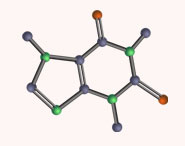


 علم الكيمياء
علم الكيمياء 
 الكيمياء التحليلية
الكيمياء التحليلية 
 الكيمياء الحياتية
الكيمياء الحياتية 
 الكيمياء العضوية
الكيمياء العضوية 
 الكيمياء الفيزيائية
الكيمياء الفيزيائية
 الكيمياء اللاعضوية
الكيمياء اللاعضوية 
 مواضيع اخرى في الكيمياء
مواضيع اخرى في الكيمياء
 الكيمياء الصناعية
الكيمياء الصناعية |
أقرأ أيضاً
التاريخ: 9-9-2019
التاريخ: 2024-04-23
التاريخ: 4-4-2017
التاريخ: 2025-04-30
|
Now that we’ve looked at the theory of how a nucleophile attacks a carbonyl group, let’s go back to the real reaction with which we started this chapter: cyanohydrin formation from a carbonyl compound and sodium cyanide. Cyanide contains sp hybridized C and N atoms, and its HOMO is an sp orbital on carbon. The reaction is a typical nucleophilic addition reaction to a carbonyl group: the electron pair from the HOMO of the CN− (an sp orbital on carbon) moves into the C=O π* orbital; the electrons from the C=O π orbital move on to the oxygen atom. The reaction is usually carried out in the presence of acid, which proto nates the resulting alkoxide to give the hydroxyl group of the composite functional group known as a cyanohydrin. The reaction works with both ketones and aldehydes, and the mechanism below shows the reaction of a general aldehyde. This reaction appeared fi rst in Chapter 5.
Cyanohydrins in synthesis, Cyanohydrins are important synthetic intermediates, for example the cyanohydrin formed from this cyclic amino ketone is the fi rst intermediate in a synthesis of some medicinal compounds known as 5HT3 agonists, which were designed to reduce nausea in chemotherapy patients.
Cyanohydrins are also components of many natural and industrial products, such as the insecticide cypermethrin (marketed as ‘Ripcord’ and ‘Barricade’).
Cyanohydrin formation is reversible: just dissolving a cyanohydrin in water can give back
the aldehyde or ketone you started with, and aqueous base usually decomposes cyanohydrins
completely. This is because cyanide is a good leaving group—we’ll come back to this type of
reaction in more detail in Chapter 10.
Cyanohydrin formation is therefore an equilibrium between starting materials and products, and we can get good yields only if the equilibrium favours the products. The equilibrium is more favourable for aldehyde cyanohydrins than for ketone cyanohydrins, and the reason is the size of the groups attached to the carbonyl carbon atom. As the carbonyl carbon atom changes from sp2 to sp3, its bond angles change from about 120° to about 109°—in other words, the substituents it carries move closer together. This reduction in bond angle is not a problem for aldehydes, because one of the substituents is just a (very small) hydrogen atom, but for ketones, especially ones that carry larger alkyl groups, this effect can disfavour the addition reaction. Effects that result from the size of substituents and the repulsion between them are called steric effects, and we call the repulsive force experienced by large substituents steric hindrance. Steric hindrance (not ‘hinderance’) is a consequence of repulsion between the electrons in all the fi lled orbitals of the alkyl substituents.
Steric hindrance
The size of substituents plays a role in very many organic reactions—it’s the reason aldehydes (with an H next to the C=O group) are more reactive than ketones, for example. Steric hindrance affects reaction rates, but also makes mole cules react by completely different mechanisms, as you will see in the substitution reactions in Chapter 15. You will need to get used to thinking about whether the presence of large substituents, with all their fi lled C–H and C–C bonds, is a factor in determining how well a reaction will go.
Cyanohydrins and cassava
The reversibility of cyanohydrin formation is of more than theoretical interest. In parts of Africa the staple food is cassava. This food contains substantial quantities of the glucoside of acetone cyanohydrin (a glucoside is an acetal derived from glucose). We shall discuss the structure of glucose later in this chapter, but for now, just accept that it stabilizes the cyanohydrin. The glucoside is not poisonous in itself, but enzymes in the human gut break it down and release HCN. Eventually 50 mg HCN per 100 g of cassava can be released and this is enough to kill a human being after a meal of unfermented cassava. If the cassava is crushed with water and allowed to stand (‘ferment’), enzymes in the cassava will do the same job and then the HCN can be washed out before the cassava is cooked and eaten.
The cassava is now safe to eat but it still contains some glucoside. Some diseases found in eastern Nigeria can be traced to long-term consumption of HCN. Similar glucosides are found in apple pips and the kernels inside the stones of fruit such as peaches and apricots. Some people like eating these, but it is unwise to eat too many at one sitting!



|
|
|
|
حقن الذهب في العين.. تقنية جديدة للحفاظ على البصر ؟!
|
|
|
|
|
|
|
علي بابا تطلق نماذج "Qwen" الجديدة في أحدث اختراق صيني لمجال الذكاء الاصطناعي مفتوح المصدر
|
|
|
|
|
|
|
ضمن برنامج تأهيل المنتسبين الجدد قسم الشؤون الدينية يقدم محاضرات فقهية وعقائدية لنحو 130 منتسبًا
|
|
|